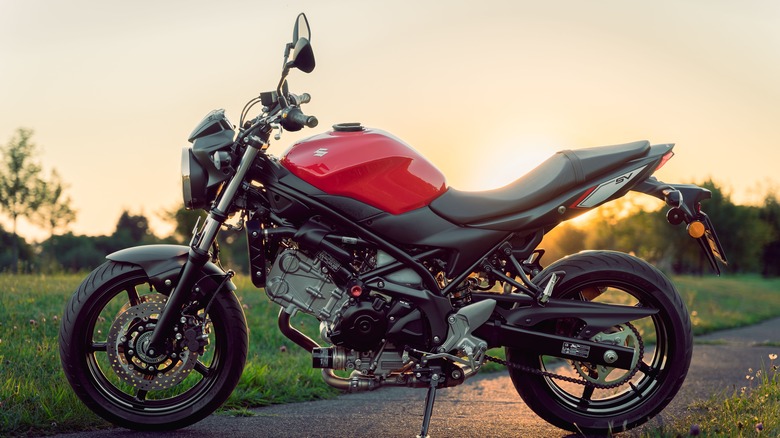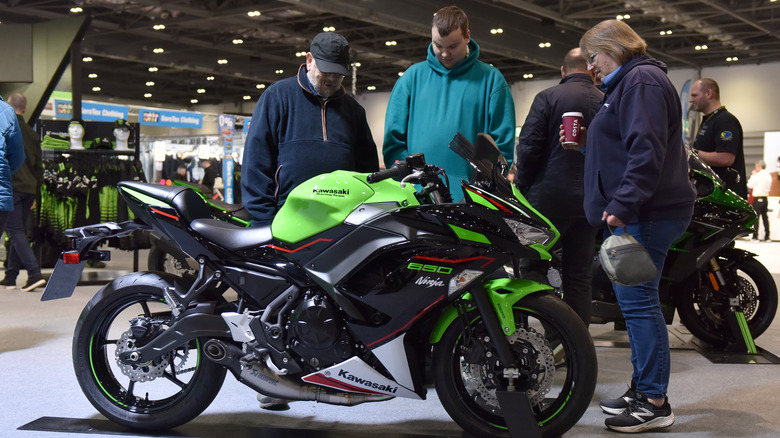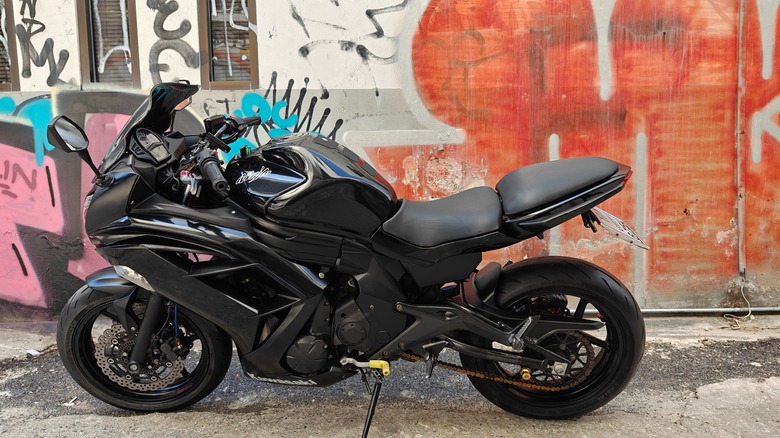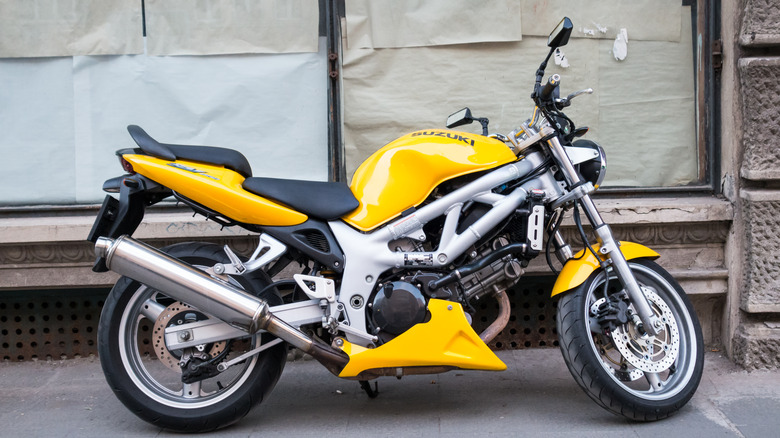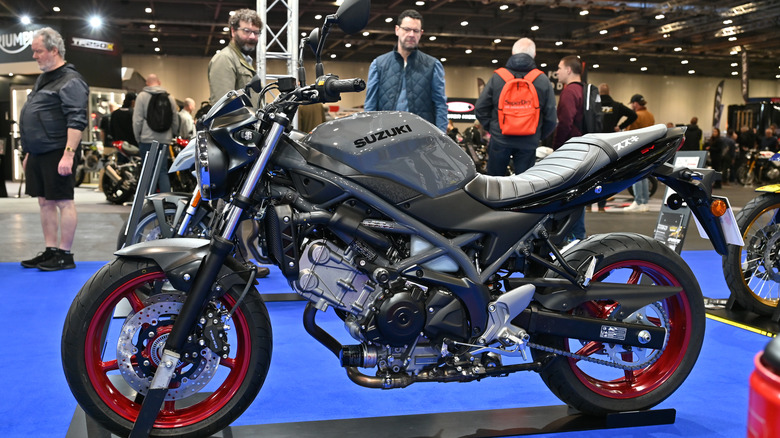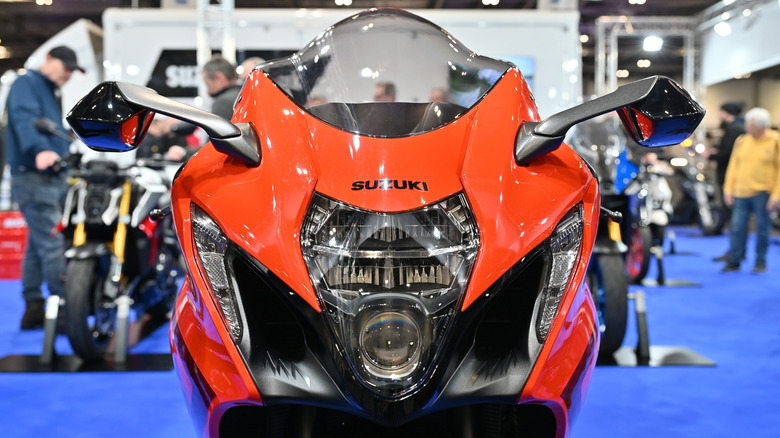Suzuki SV650 Vs. Kawasaki Ninja 650: How Do These Bikes Compare?
Kawasaki's Ninja motorcycles have developed quite the reputation as speed machines. The Ninja 650 is a sports tourer with an aggressive, angular sense of style and a parallel-twin 649cc engine. It was introduced in 2006 as the 650R, and six years later with a series of adjustments, reborn as the Ninja 650.
The Ninja 650 is comparable to Suzuki's SV650, one of the many cool Suzuki motorcycles, and a potent model in the middle of its manufacturer's weight line-up. The SV650 actually arrived seven years earlier, in 1999, with both the half-fairing Suzuki SV650S and naked SV650 models available. In both its initial guises, the SV650 looked distinctly different to the 650 that arrived later, but underneath it all, they were certainly kindred spirits.
It's important for everyday riders to have options for sporty models that retain a sense of style and power while still offering practical use beyond the racing side of things. This is the purpose of both Kawasaki's Ninja 650 and the Suzuki SV650 in a nutshell. They're stylish, sporty, powerful machines, not topping the charts in on-paper specs but absolutely packing enough to please a wide variety of street riders.
For those looking to see how they compare, we'll run through their respective specs, prices, features, and more to help potential purchasers make a choice between them.
The specs and dimensions of the models
There's often no more important point of comparison between two rival vehicle models than their raw size and power. It's a great place to start, then.
Beginning with the Suzuki SV650, the model boasts 72 hp and 47.2 lb-ft of torque in its four-stroke V-twin engine, which has a capacity of 645cc. In terms of size, it measures 29.9 inches wide by 42.9 inches tall and 84.3 inches long. Boasting a curb weight of 437 lbs to boot, it's a middleweight model, yet with practical abilities.
The '25 Ninja 650, meanwhile, is cut from similar cloth. Kawasaki's effort has the slimmest lead in terms of power capacity, offering a 649cc parallel twin eight-valve engine with 48.5 lb-ft of torque. This is all wrapped up in a package that's just slightly lighter than the SV650, at 421.2 lbs, or 423.4 lbs when equipped with ABS. The bike measures 80.9 inches in length by 45.1 inches high and 29.1 inches wide. Also, at 68 horsepower as of the '23 edition, it's quite clear that, in terms of their basic specs and size, the two models aren't tremendously different from each other. Next, there's the financial factor — let's see how each bike will stretch your budget.
How much can the Kawasaki Ninja 650 cost?
The beginning MSRP of the '25 Kawasaki Ninja 650 is $8,299. However, buyers are likely to pay more than just that price. With a destination charge of approximately $550, plus the additional $600 when adding the anti-lock braking system, this sets you back $9,449. It's not as affordable as some other Kawasakis.
That's just the beginning, too. As any rider knows, there are a range of modifications available for a new motorcycle. For example, you'll need to consider your 650's paint job. The Metallic Spark Black and Metallic Flat Spark Black model is available at the base $8,299, but if you want either Metallic Matte Old School and Metallic Spark Black or Candy Steel Furnace Orange, Metallic Spark Black and Metallic Royal Purple, both of the latter add $600 to the overall total.
There are also options to add the likes of Kawasaki's Premium Cover ($184.95), Large Windshield ($225.95), DC Power Outlet ($55.95), or 30 Liter Top Case ($110.95) to a purchase.
How much can a Suzuki SV650 cost?
Moving on to the Suzuki SV650, the company offers the '23 base model at an MSRP of $7,399. On top of this, there's a potential destination charge of $440 and a $150 freight surcharge where applicable. Again, the ABS model is offered at a premium — it's $7,949, with the same two additional charges being $460 and $100 respectively. At $8,509 for an ABS model with the additional charges all accounted for, this makes the SV650 $940 less than an equivalent ABS Ninja 650.
As for potentially not-so-optional extras, Suzuki has its own range of official add-ons for SV650 riders too. They include the Suzuki Cycle Cover ($149.95), passenger pegs ($39.95), a tuck roll seat ($219.95), and a 27 liter top case at $129.95 – which is slightly less capacity but pricier than Kawasaki's equivalent.
Weighing up the prices of the two models, while Suzuki's SV650 has a lower base price, it won't necessarily be the cheaper choice, depending on the suite of accessories the buyer might like to add to their purchase. The savviest shoppers will look at any potential savings versus those elements of the package that are the most valuable to them.
Are the SV650 and Ninja 650 beginner friendly?
A first motorcycle is a hugely significant purchase, and it could become your pride and joy for a lifetime. It needn't be a bike that you outgrow or graduate from. Whether you're considering a Ninja 650 or an SV650 as your first bike or just your latest, you'll find that they're well equipped for a range of needs and skill levels.
These are vehicles designed to be comfortable rides to both sit on and manage. As Cycle World put it in a Buyer's Guide for the '22 SV650, "The SV happily served everyone from first-timers to old-timers, many of whom kept them on as long-timers. It's the rare motorcycle that can be both a first and a forever bike."
The Suzuki SV650 has a seat height of 30.9 inches, with Kawasaki's effort slightly higher, at 31.1 inches. Both are versatile bikes, comfortable for longer trips just as they're convenient for shorter journeys. As convenient packages that bundle relatively low costs with a sporty appeal and adaptability, riders may upgrade to a model with even more heft down the line, but by the same token, they may never see the need to.
Which motorcycle could be a better fit for you?
Competition means that if a particular model of vehicle proves a success, you can bet that rivals will get to work on something to counter it as soon as possible. As a result, of course, the choice between them can be a difficult one, with little to separate the two.
This is the case with the SV650 and Ninja 650. Both are popular mainstays of the twin-engine arena, and very close competitors to boot. They could be considered motorcycles for the non-specialized rider, as they're not tailored for off-roading as Kawasaki's KLX300R is, nor do they boast the sheer 1,340cc strength of Suzuki's Hayabusa, or the monstrous speed of the Ninja H2R. Unlike the $19,599 price tag of the Hayabusa, they're affordable, versatile models that can be accessorized for certain roles, even if not specifically designed for them.
The SV650's lower price could be a significant point in its favor. Nevertheless, both are very solid entries in the middle-of-the-pack range, and a potential buyer should consider the add-ons that might suit them.
